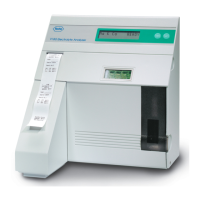Roche Diagnostics
Instructions for Use · Version 10.0 41
9180 Electrolyte Analyzer 3 Specifications
Relationship of ionized calcium to total calcium
Relationship of ionized calcium to total calcium
Approximately 50% of calcium circulates as free calcium ions (Ca
2+
), also described
as ionized calcium, and is physiologically active. 40% of calcium is bound to plasma
proteins (largely albumin) and the remaining 10% is complexed with small anions
(e.g. bicarbonate, lactate, phosphate)
(1)
.
Total serum calcium is directly related to the serum albumin concentration. The
lower the serum albumin, the higher the portion of the total calcium that is present in
ionized form. In the presence of hypoalbuminemia, although total calcium level may
be low, the ionized calcium level may be normal. Further, acid base disturbances
affect the ratio of total calcium to ionized (free) calcium
(2)
.
Bibliography
o Bishop ML, Duben-Engelkirk JL, Fody EP. Clinical Chemistry Principles
Procedures Correlations. 2nd Ed. Philadelphia: J.B. Lippincott; 1992; 281.
o Burritt MF, Pierides AM, Offord KP Comparative studies of total and ionized
serum calcium values in normal subjects and in patients with renal disorders.
Mayo Clinic Proc. 1980; 55: 606.
o Burtis C, Ashwood E (eds.). Tietz Textbook of Clinical Chemistry. 2nd Ed.
Philadelphia: W.B. Saunders; 1994; 1354-1360, 2180-2206.
o Calbreath DF. Clinical Chemistry A Fundamental Textbook. Philadelphia: W.B.
Saunders; 1992; 371, 376, 390-395.
o Henry RJ. Clinical Chemistry - Principles and Technics. New York: Harper and
Row; 1974.
o Kost GJ. The significance of ionized calcium in cardiac and critical care.
Availability and critical limits at US medical centers and children’s hospitals.
Arch. Path. Lab. Med. 1993; 117(9): 890-96.
o Clinical and Laboratory Standards Institute. Protection of Laboratory Workers
from Occupationally Acquired Infections; Approved Guideline—Third Edition.
CLSI Document M29-A3. Wayne, PA: Clinical and Laboratory Standards
Institute; 2005.
o National Committee for Clinical Laboratory Standards. Additives for Blood
Collection Devices: Heparin; Tentative Standard. NCCLS Document H24-T.
Wayne, PA: National Committee for Clinical Laboratory Standards; 1988.
o Clinical and Laboratory Standards Institute. Evaluation of Precision Performance
of Quantitative Measurement Methods; Approved Guideline—Second Edition.
CLSI Document EP5-A2. Wayne, PA: Clinical and Laboratory Standards
Institute; 2004.
o Rose BD. Clinical Physiology of Acid-Base and Electrolyte Disorders. 4th Ed. New
York: McGraw-Hill; 1993; 346-348, 432, 797-798.
(1) Burtis CA, Bruns DE, Ashwood ER (eds.). Tietz Textbook of Clinical Chemistry and Molecular
Diagnostics. 5th Ed. Elsevier Saunders; 2012.
(2) Part 10.1: Life-Threatening Electrolyte Abnormalities, 28 Nov 2005, Circulation. 2005;112:IV-121-IV-
125, DOI 10.1161/CIRCULATIONAHA.105.166563;
Alexander RT, Cordat E, Chambrey R, Dimke H, Eladari D. Acidosis and Urinary Calcium Excretion:
Insights from Genetic Disorders. J Am Soc Nephrol. 2016;27(12):3511-3520.
doi:10.1681/ASN.2016030305

